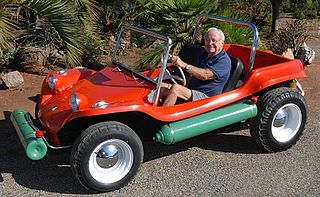
A dune buggy — also known as a beach buggy — is a recreational motor vehicle with large wheels, and wide tires, designed for use on sand dunes, beaches, roads or desert recreation.
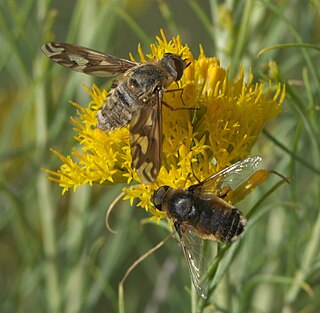
Poecilanthrax willistoni, Williston's bee fly or sand dune bee fly, is a member of the Bombyliidae insect family. This family includes the bee flies, true flies that have developed Batesian mimicry characteristics to avoid predators. That is, they look like bees because that helps them avoid bee-wary predators, but they lack stingers.

The Algodones Dunes is a large sand dune field, or erg, located in the southeastern portion of the U.S. state of California, near the border with Arizona and the Mexican state of Baja California. The field is approximately 45 miles (72 km) long by 6 miles (9.7 km) wide and extends along a northwest-southeast line that correlates to the prevailing northerly and westerly wind directions. The name "Algodones Dunes" refers to the entire geographic feature, while the administrative designation for that portion managed by the Bureau of Land Management is the Imperial Sand Dunes Recreation Area. In 1966, Imperial Sand Hills was designated as a National Natural Landmark by the National Park Service. The Algodones Dunes are split into many different sections. These sections include Glamis, Gordon's Well, Buttercup, Midway, and Patton's Valley. Although the Arabic-derived Spanish word algodones translates to "cotton plants", the origin of the toponym is unknown.
Coelus globosus is a species of beetle in family Tenebrionidae. It is found in Mexico and the United States.
The Globose Dune Beetle inhabits foredunes and sand hummocks immediately bordering the coast from Bodega Bay Head to Ensenada, Baja California, and all of the Channel Islands except San Clemente Island.
Coelus gracilis is a species of beetle in family Tenebrionidae. It is endemic to the United States.
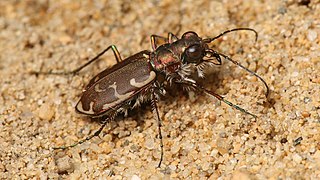
Cicindela repanda, commonly known as the bronzed tiger beetle or common shore tiger beetle, is a species of tiger beetle that measures 10–13 millimetres (0.39–0.51 in) long, lives in most of North America. Its labrum is small with one tooth and the pronotum is coppery and hairy. The shoulder marking touches or nearly touches the middle band. It is usually seen in spring and summer and it lives in sand, gravel, or clay soil. Its food is many insects and some fruit. The species have a two-year life cycle. It can be found all across sand dunes around the Great Lakes. The species comprises three subspecies: C. repanda repanda, C. repanda novascotiae, and C. repanda tanneri.
Lutica is a genus of zodariid spiders that occurs only in North America on both the mainland California coast and the Channel Islands. Lutica abalonea is known from the coast west of Oxnard, California, Lutica clementea is known from San Clemente Island, Lutica maculata is known from Santa Rosa Island, and Lutica nicolasia is known from San Nicolas Island. It is believed that there is another species found on San Miguel Island, though it has not been described due to lack of adult specimens.
BugGuide is a website and online community of naturalists, both amateur and professional, who share observations of arthropods such as insects, spiders, and other related creatures. The website consists of informational guide pages and many thousands of photographs of arthropods from the United States and Canada which are used for identification and research. The non-commercial site is hosted by the Iowa State University Department of Entomology. BugGuide was conceived by photographer Troy Bartlett in 2003 and since 2006 has been maintained by Dr. John VanDyk, Adjunct Assistant Professor of Entomology and Senior Systems Analyst at Iowa State University. The website has been recognized for helping change public perception of insects.
Microdon globosus is a species of syrphid fly in the family Syrphidae.
Neoxenus is a genus of fungus weevils in the beetle family Anthribidae. There are about six described species in Neoxenus.
Polyphylla avittata, known generally as the spotted Warner valley dunes June beetle or spotted Warner valley dunes scarab beetle, is a species of scarab beetle in the family Scarabaeidae. It is found in North America.
Cadiz is a genus of leaf beetles in the subfamily Chrysomelinae, found in North America. It contains only one species, Cadiz hardyi, which was described from the Cadiz Dunes in San Bernardino County, California.
Pseudocotalpa andrewsi, known generally as the Andrews dune scarab beetle or Andrews dune beetle, is a species of shining leaf chafer in the family Scarabaeidae. It is endemic to the Algodones Dunes in California.
Anomala hardyorum, or Hardys' dune beetle, is a species of shining leaf chafer in the family Scarabaeidae. It is endemic to the Algodones Dunes in North America.
Dendrosinus is a genus of crenulate bark beetles in the family Curculionidae. There are about 12 described species in Dendrosinus.
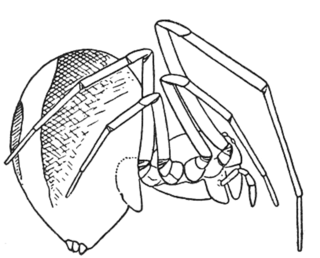
Hentziectypus globosus is a species of cobweb spider in the family Theridiidae. It is found in North America.
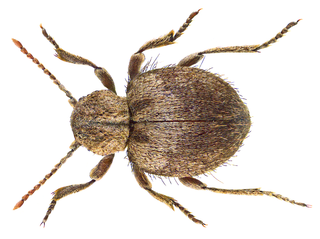
Trigonogenius is a genus of spider beetles in the family Ptinidae. There are about six described species in Trigonogenius.
Germarostes globosus is a species of pill scarab beetle in the family Hybosoridae. It is found in North America.
Canopus is a genus of Neotropical bugs with about six species that form the family Canopidae. Bugs in the family Canopidae are small (5–7 mm) long and have a convex lady-bird beetle like shape and are thought to be fungus feeders. The scutellum completely covers the abdomen and wings. The antennae are five segmented.

Coniontini is a tribe of darkling beetles in the subfamily Pimeliinae of the family Tenebrionidae. There are at least 4 genera in Coniontini, found in North America.






